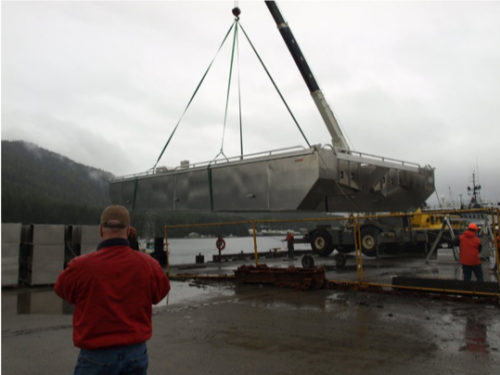Alaska Sea Grant helps oyster company expands its reach
July 31, 2019
Paula Dobbyn
9072749698

An Alaska oyster farmer on Prince of Wales Island is hoping that a new device he spent years helping to design will increase his oyster farming productivity and prove useful to others around the state.
The redesigned device is a 53-foot aluminum floating upweller system, or FLUPSY. It works by moving fresh seawater filled with plankton into troughs containing maturing oysters while pushing old water out. Although a few other farmers in Alaska have FLUPSYs, Eric Wyatt’s design is not only unique, it also sets a new standard.
Alaska Sea Grant agent Gary Freitag assisted in launching the new FLUPSY earlier this summer.
“This has the potential to expand the oyster farming industry in Alaska. It provides substantially more planktonic food to the oysters during the farming operation, which will accelerate growth,” said Freitag, a professor at UAF College of Fisheries and Ocean Sciences. Alaska Sea Grant is a partnership between the National Oceanic and Atmospheric Administration and CFOS.
Oyster farming uses various strategies to reproduce, grow and harvest oysters. However, using a controlled environment with a flow-through system has been found to be the most successful. In order to mature the oysters, it’s important that they receive a diverse diet of phytoplankton. A flow-through system not only allows for a beneficial diet, but also allows the farmer to mimic a winter-to-summer transition, controlling when the oysters spawn.
Wyatt launched his FLUPSY on May 7 in Ward Cove, Ketchikan, and then towed it for three days to his home and oyster farm in Tokeen Bay on the northwest side of Prince of Wales Island. Wyatt’s oyster farming operation is one of 19 in the state, according to the Alaska Department of Fish and Game.
For two years, Wyatt worked closely with Ben Crew of Ketchikan-based Crew Enterprises to design the FLUPSY. The first year was spent optimizing the design while the second year was devoted to construction. Crew said that with his knowledge of metals and Wyatt’s oyster expertise, they made a perfect match to design the technology together. While Wyatt spent time studying similar setups in Alaska and Washington, Crew focused on flotation and design ideas.
After extensive planning, Crew and Wyatt settled on incorporating a 6-foot-long, 5-foot-wide paddle wheel powered by a five-horsepower gasoline motor to move the seawater into the 16 oyster troughs. Allowing more water into the system gives the oysters ample food, encouraging their growth to skyrocket.
“You don’t get that flow naturally, you have to pump it. The continuous flow of sea water has the food,” Wyatt said.
In addition to the paddle wheel, the upgraded design features a submersible system — allowing oysters to be further extended into the water. Both Crew and Wyatt agreed that the submersible design allows for convenient height adjustment due to varying production weight as well as easy access to all areas of the FLUPSY while in use.
Weatherly Bates, owner of Alaska Shellfish Farms, explained that using a FLUPSY in Alaska is the best bet for becoming a successful oyster farmer. She emphasized that Wyatt’s design has the potential to be successful.
“We grow the oysters at our farm with deep-water suspended gear, which is similar to Wyatt’s FLUPSY design, however, ours is much smaller,” Bates said. “But, using a FLUPSY nursery is a proven successful design.”


